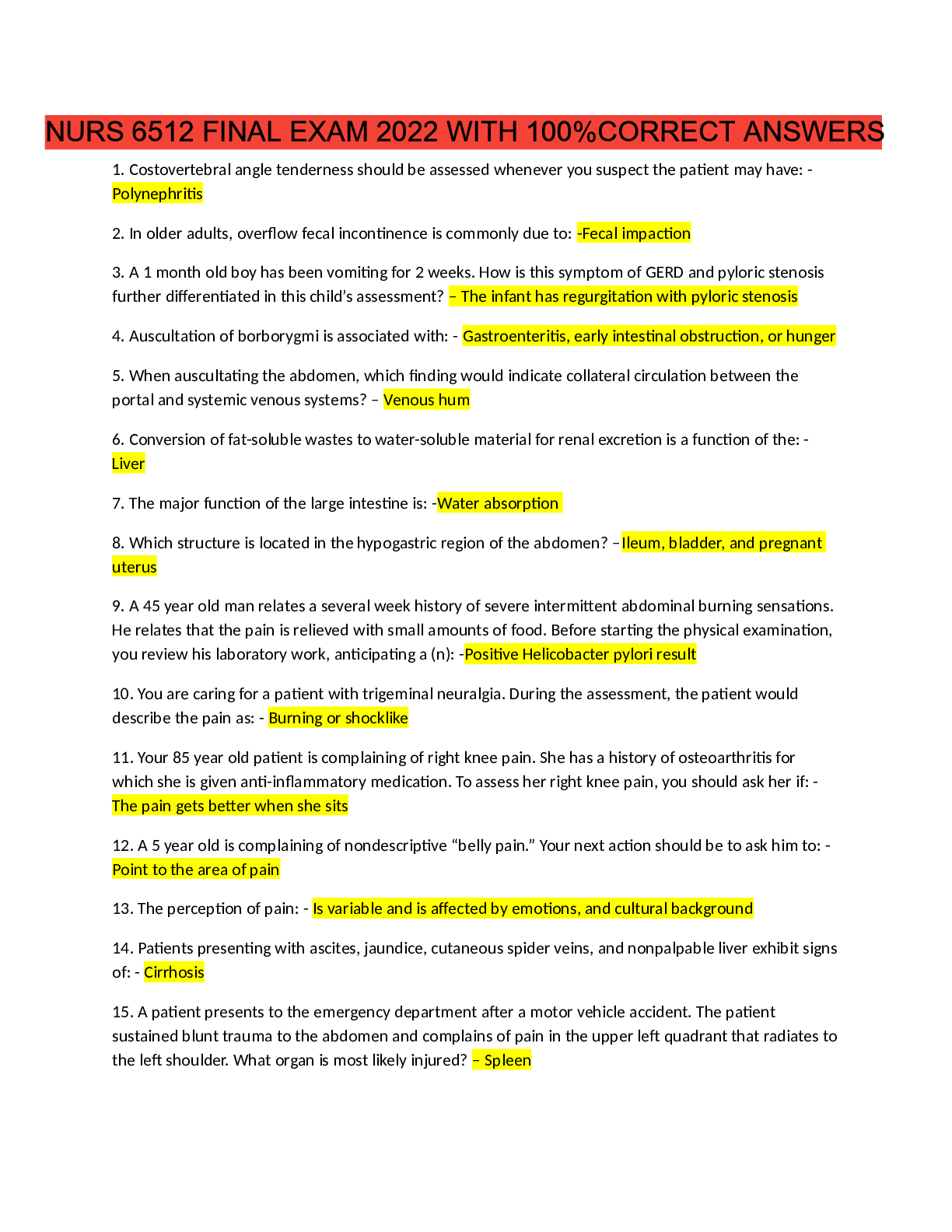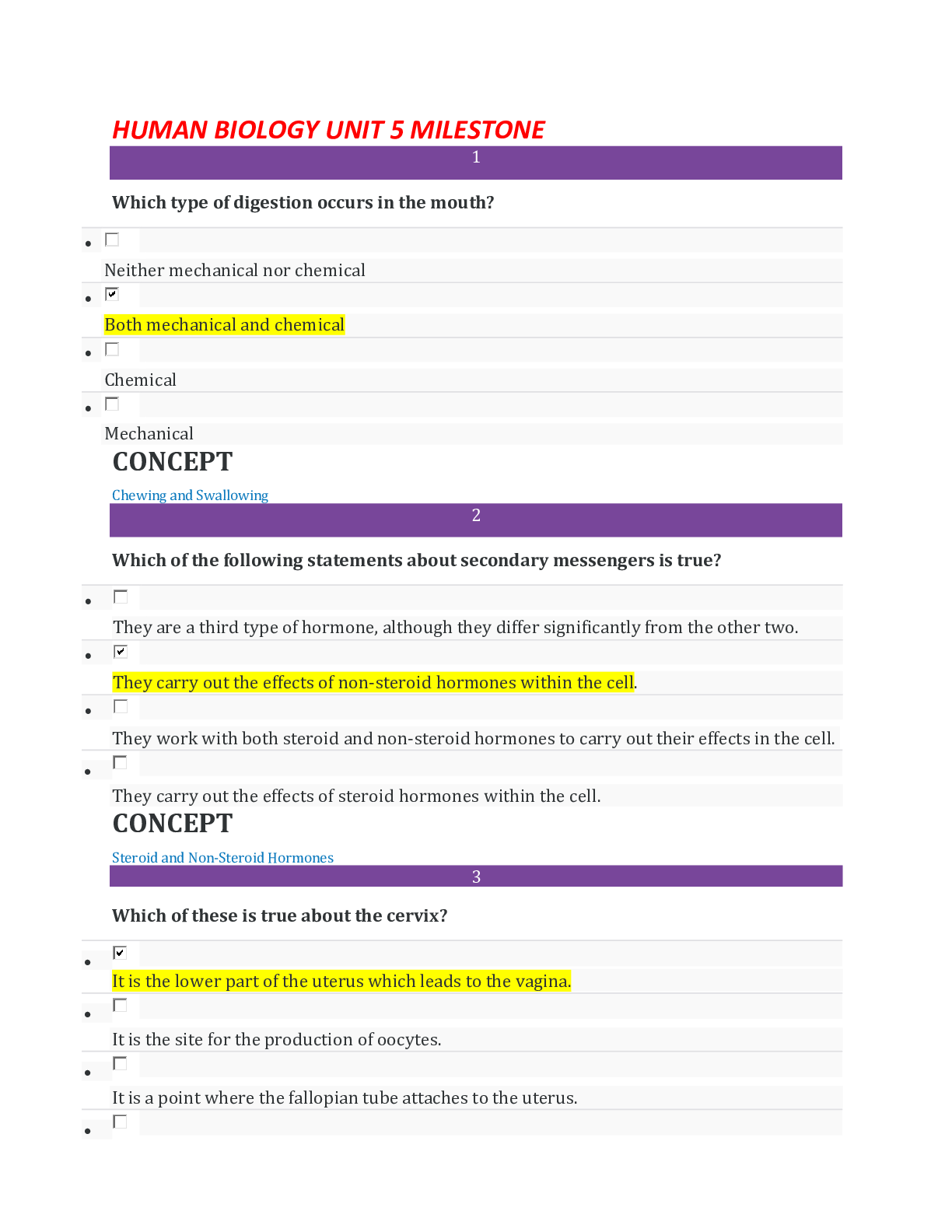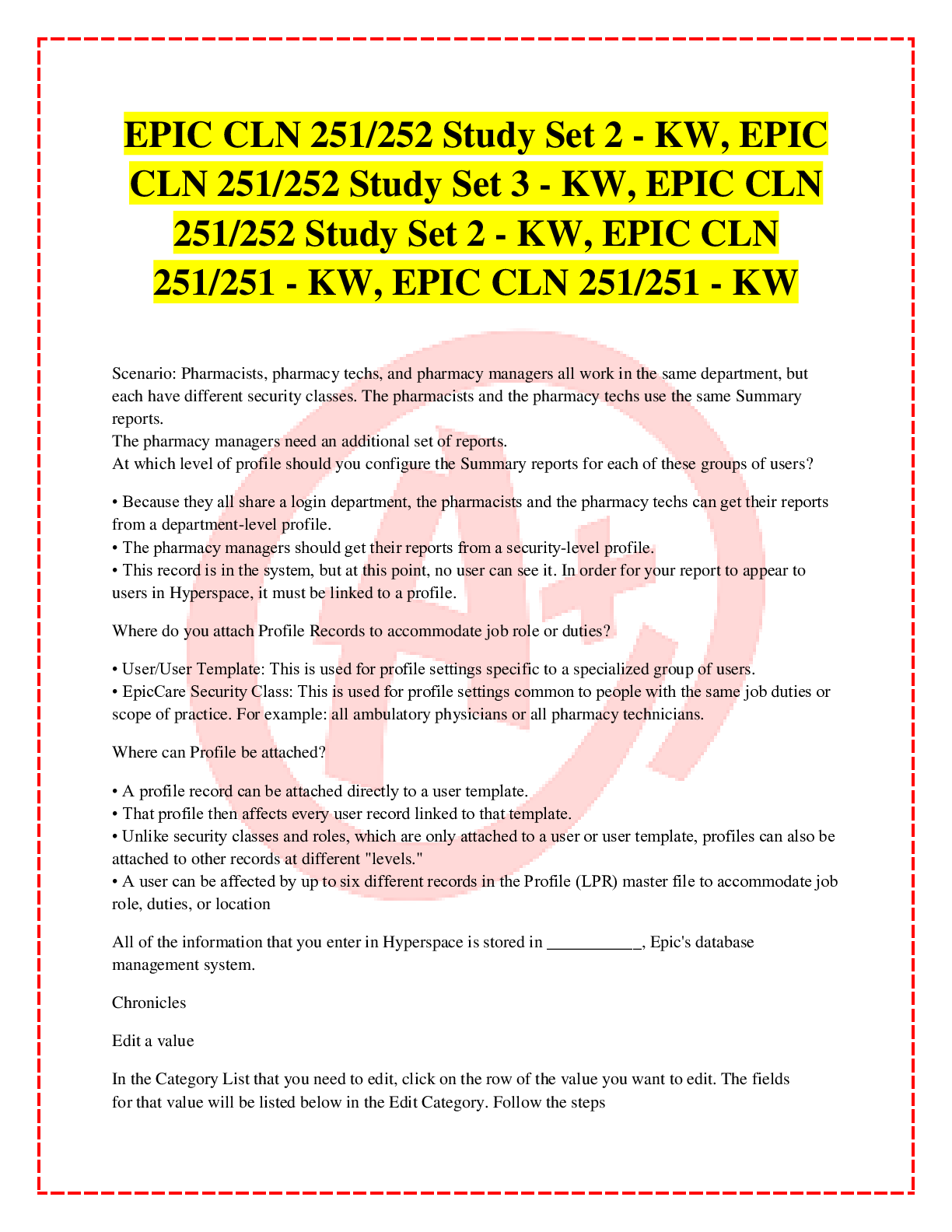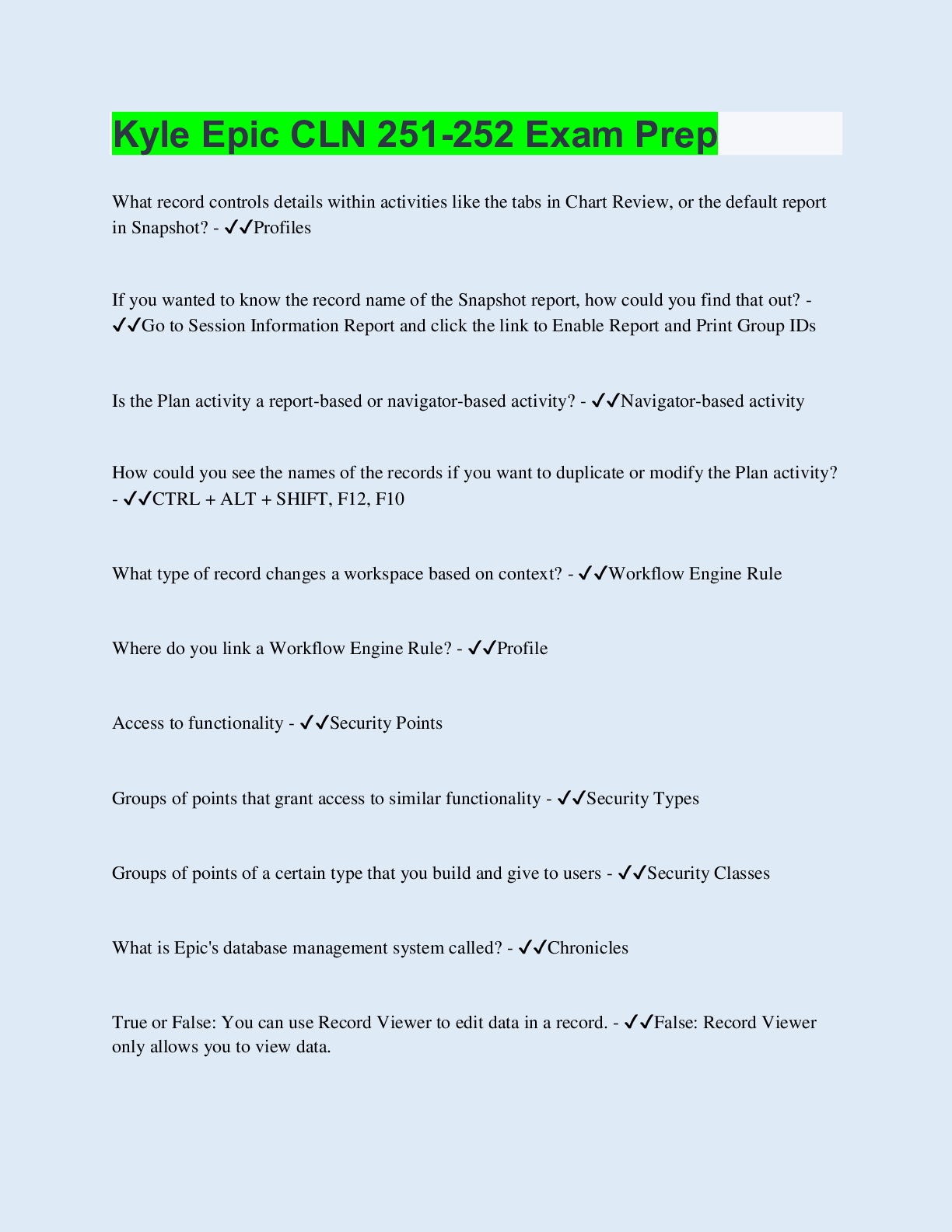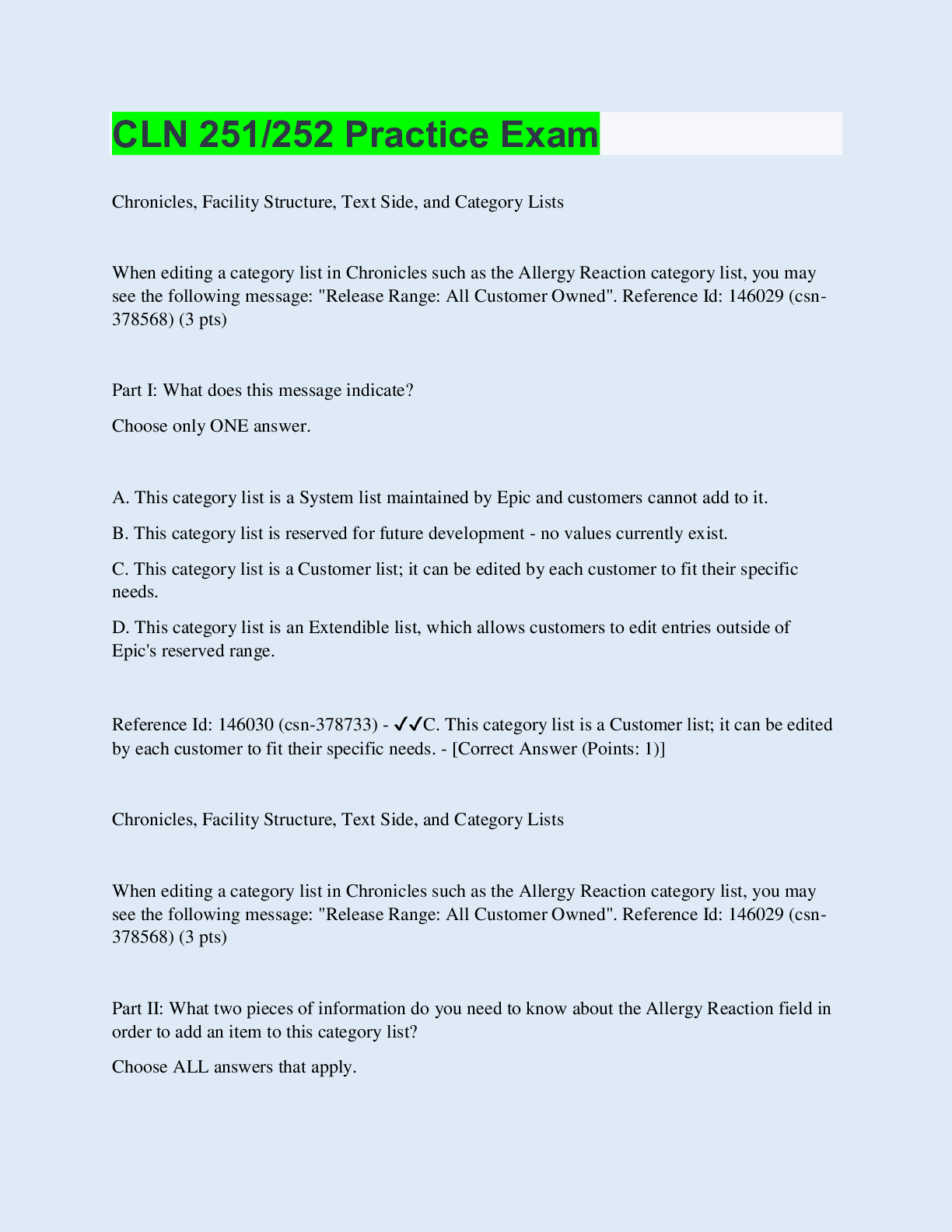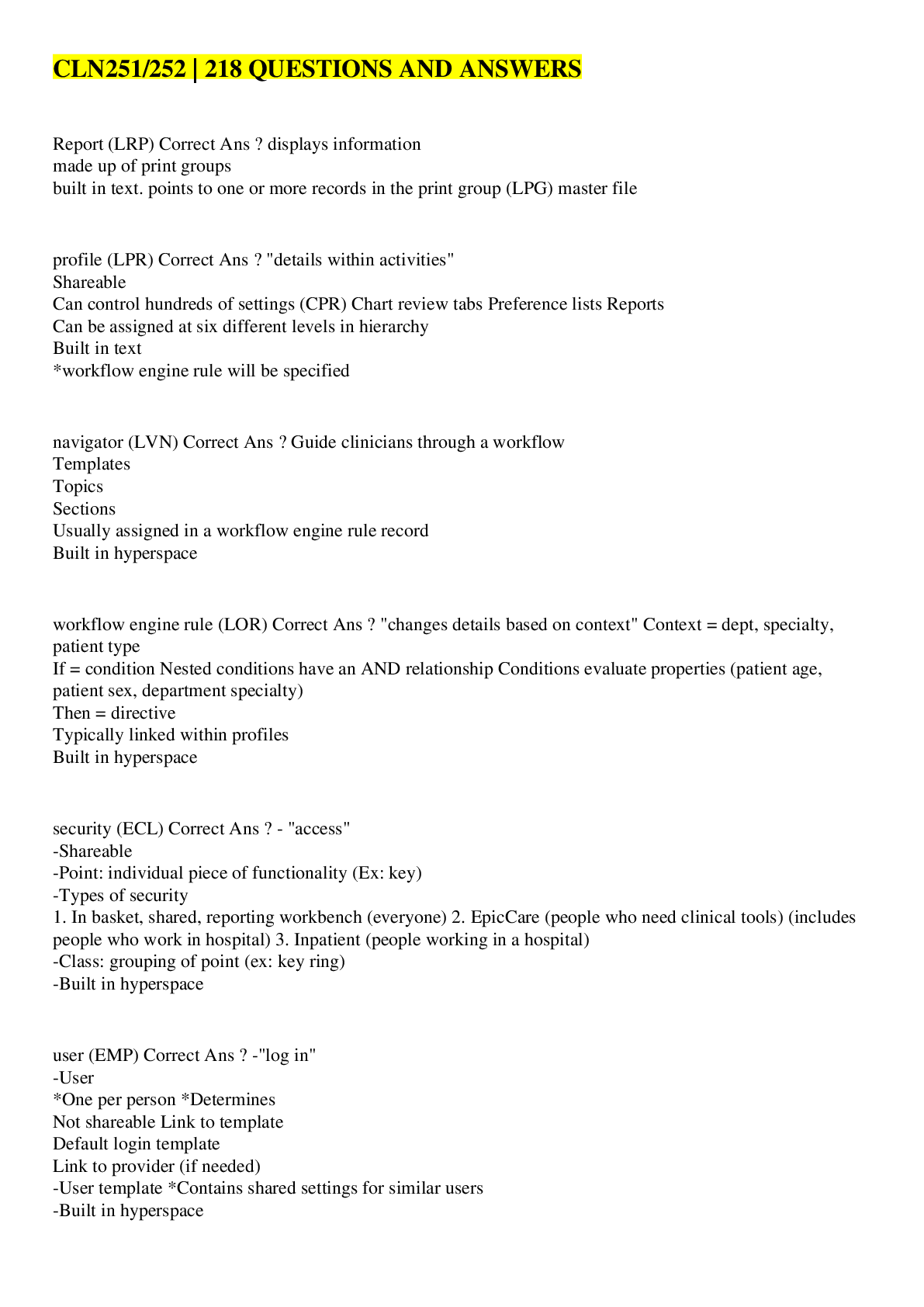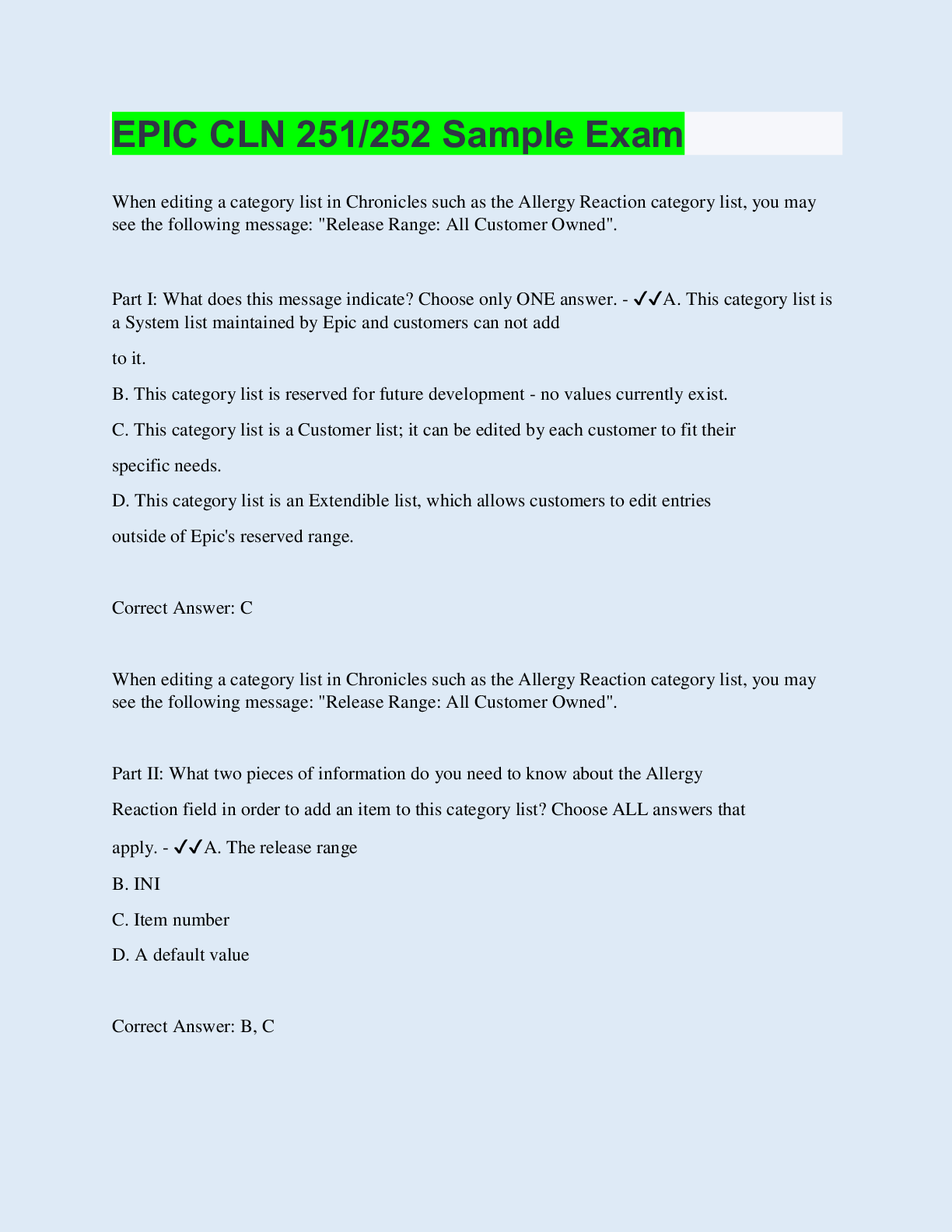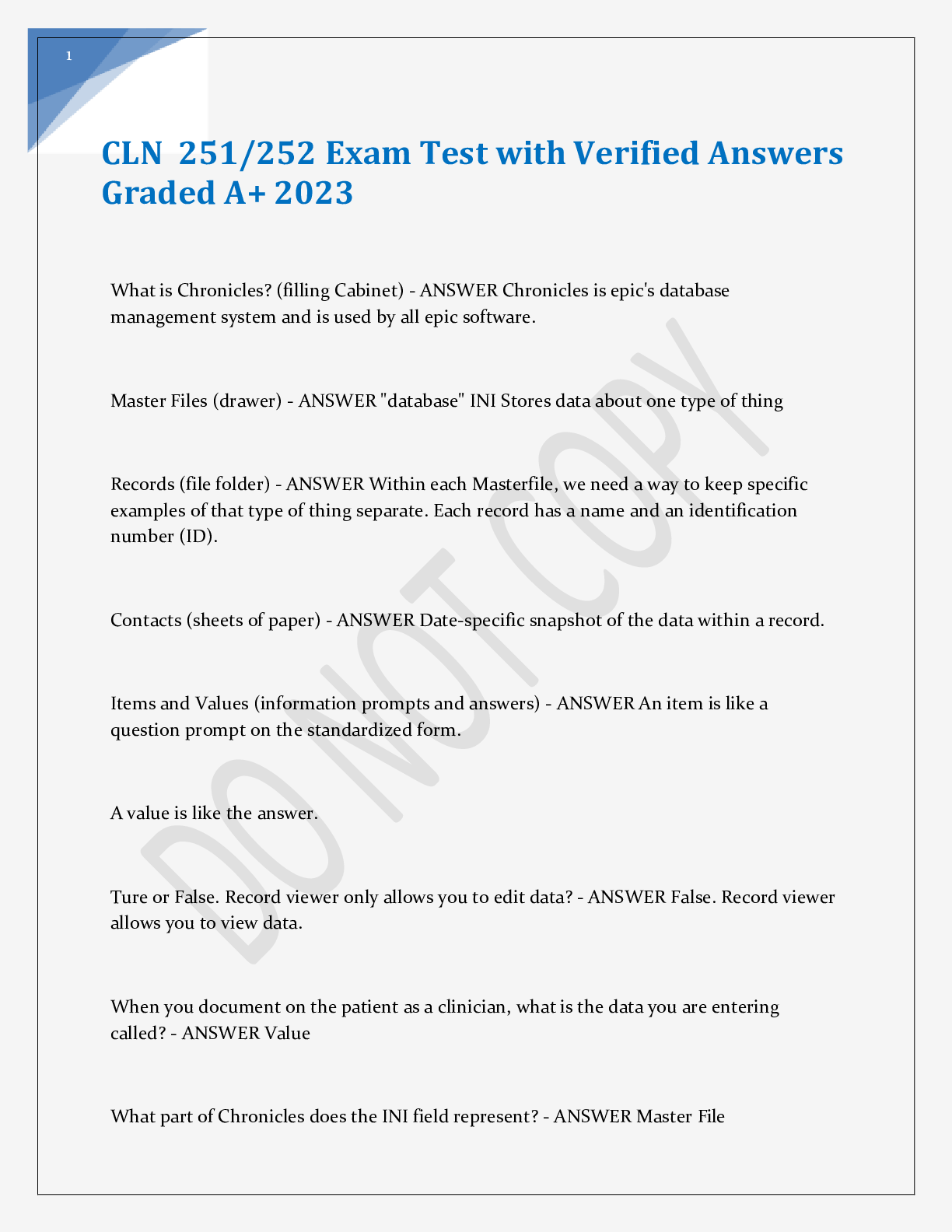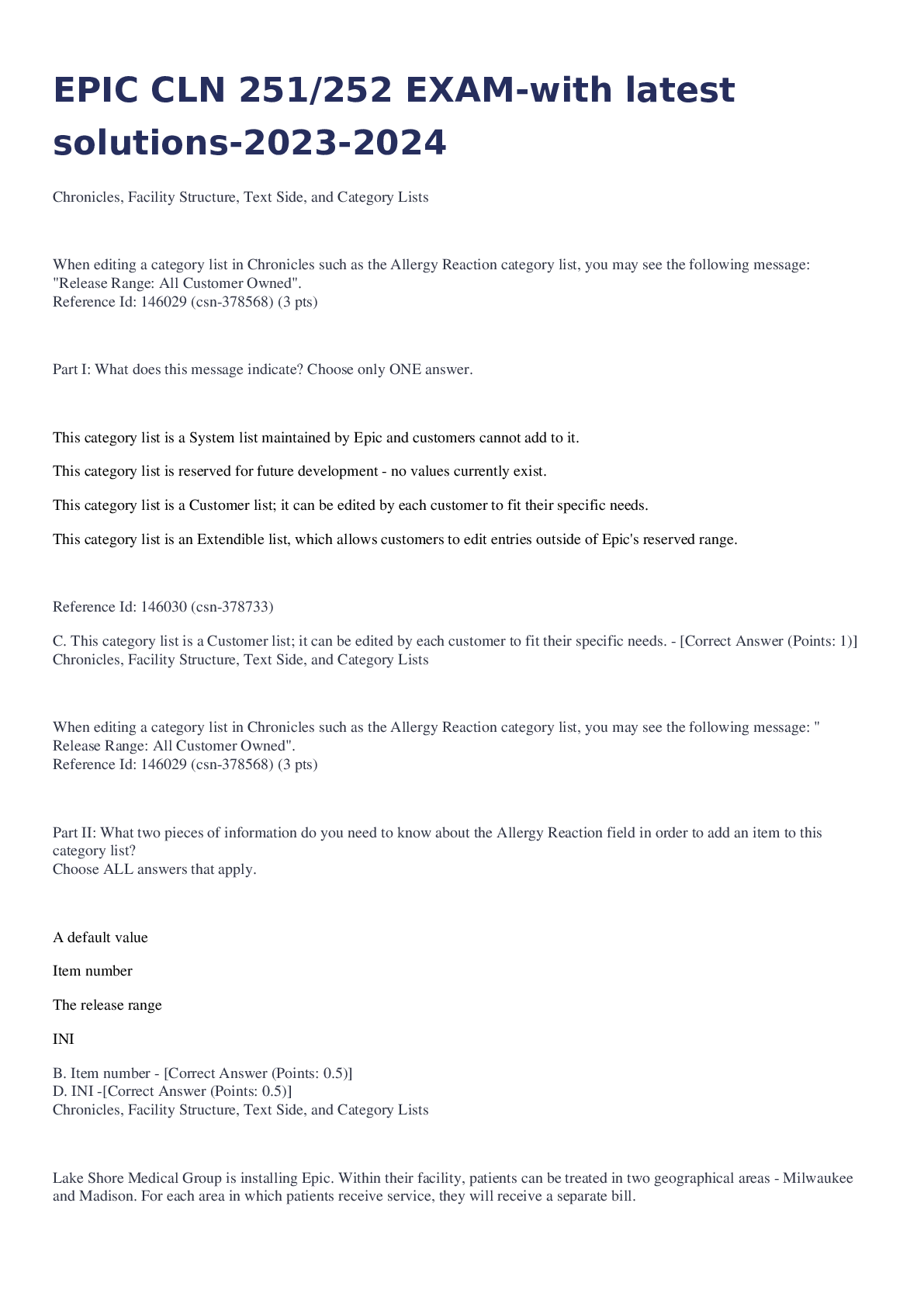*NURSING > EXAM > Rasmussen College: MEDICAL AS 242 Module 4 Practice Notes CAPSTONE,100% CORRECT (All)
Rasmussen College: MEDICAL AS 242 Module 4 Practice Notes CAPSTONE,100% CORRECT
Document Content and Description Below
Rasmussen College: MEDICAL AS 242Module 4 Practice Notes CAPSTONE Module 4 Practice Quiz 1. Acute bursitis is an inflammation of the fluid filled portion of a join in the shoulder. Resting the... joint, intermittent ice and heat, and NSAIDS are included in the conservative management of acute bursitis. 2. Sickle cell crisis: low grade fever, tachycardia, and pain from the tissue hypoxia and necrosis. 3. Chronic cholecystitis occurs following several bouts of cholecystitis. The repeated episodes of inflammation result in a fibrotic and contracted gallbladder. Because of inflammation in the gallbladder, bile needed to absorb fat- and fat-soluble vitamins is unable to enter the bowel, resulting in steatorrhea (fatty stools). Right upper quadrant pain that can radiate to the back or the right scapular. Jaundice can occur. 4. Biliary obstruction results in excretion of bile through the kidneys, rather than the bowel, which results in dark colored urine. 5. Diabetes mellitus: reduce cholesterol and saturated fat intake since most DM patients die from myocardial infarction or heart failure. Keep LDL below 100 mg/dl. Increase physical activity and exercise daily to improve lipid profile and reduce risk for heart disease. Smoking cessation is important since it can cause vasoconstriction of vessels. Vasoconstriction increases risk for MI and stroke. Maintain optimal BP to prevent kidney damage. Nephropathy is a pathologic change in the kidney and that reduces function and leads to kidney failure. Diabetes is the leading cause of end-stage kidney disease. 6. Chemotherapy: avoid drinking liquids an hour before treatments since it can cause nausea and vomiting. Increase calorie intake. 7. Iron deficiency anemia: tomato juice increases absorption. Tea, milk, and dried beans impairs absorption. 8. Age related musculoskeletal changes: decreased muscle mass, vertebral disk atrophy, chest and pelvic width increase with age, force of muscle contraction decreases. 9. Maternal newborn blood group incompatibility is the most common form of pathologic jaundice, and the jaundice appears within the first 24 hours of life. Physiologic jaundice occurs AFTER 24 hours. Maternal cocaine use: too small for gestational age, tremors, irritability, hyperactivity to stimuli, and poor feeding. 10. Heart sounds: turbulence between S1 and S2 heart sounds is a systolic murmur. Third heart sound is an extra sound that is low pitched and occurs in early diastole. A fourth heart sound is an extra heart sound that is low pitched and occurs in late diastole. 11. A nurse is caring for a client who has a herniated lumbar disc and reports pain. The nurse should assist the client into which of the following positions to help reduce the pain? a. crown with her arms raised above her head b. semi fowlers with a pillow under her knees c. supine with her arms elevated on pillows d. supine with the head of the bed elevated to 15 degrees 12. A nurse is providing teaching for a client who has a recent diagnosis of depression. Which of the following should the nurse identify as a primary risk factor for this disorder? a. Recent history of stressful positive life events b. past history of childhood trauma c. being only a child d. having elevated levels of serotonin 13. A nurse is planning teaching for the parents of a toddler who follows a vegetarian diet. The nurse should plan to include which of the following foods as the best source of dietary protein for the child? a. Soy milk b. peanut butter c. dried beans d. whole grains 14. Add nurses caring for a client who has a new diagnosis of type one diabetes mellitus period to focus on effective learning with this client, which of the following intervention should the nurse use? a. Ask the client to perform a return demonstration of insulin injection b. review the action of insulin therapy c. explore the clients’ feelings about dietary modifications d. have the client practice of blood glucose monitoring using a glucometer 15. A nurse is caring for a client who has end stage renal disease. Which of the following are expected findings a. slurred speech b. bone pain c. Bradypnea d. pruritus e. hypotension 16. A nurse is caring for a client who is postoperative following a laminectomy with spinal fusion. Which of the following actions should the nurse take a. monitor sensory perception of the lower extremities b. assist the client into a knee chest position to manage postoperative discomfort c. maintain strict bed rest for the first 48 hours postoperative d. position the client in a high fowlers position if clear drainage is noted on the dressing 17. A nurse is caring for a client who is in active labor when the client's membranes rupture. The fetal monitor tracing show late decelerations. Which of the following action should the nurse take first? a. Palpate the clients uterus b. administer oxygen to the client c. increase the client IV fluid infusion rate d. turn the client on to her side 18. A nurse in a dermatologist office is planning an educational session about skin cancer. Which of the following should the nurse include at risk factors for skin cancer? a. Dark skin b. under 40 years of age c. overexposure to UV light d. previous skin injury e. genetic predisposition 19. A nurse is teaching a client who has a new diagnosis of hyperparathyroidism. The nurse should include in the teaching that the client is at risk for which of the following complications? a. Impaired skin integrity b. fluid retention c. pathologic fractures d. dysphasia 20. A nurse is talking with a client who is beginning a program of moderate exercise. The client asks the nurse why warm up exercises are necessary. Which of the following responses should the nurse make? a. Warm up exercises reduce the risk for muscle fatigue b. warm up exercises reduce the risk for lactic acidosis c. warm up exercises reduce the risk of injury d. warm up exercises reduce the risk for tachycardia 21. A nurse is assessing a client who has a puncture wound on his foot. Which of the following findings is a manifestation of acute osteomyelitis? a. Numbness of the toes on the affected foot b. Hypothermia c. localized erythema d. Brady cardia 22. A nurse is providing teaching about an ileostomy care to a client. which of the following statements by the client indicates a need for further teaching a. I will empty my pouch when it becomes 1/3 full b. I will be certain to take an enteric coated medication c. I will change my entire pouch system at least weekly d. I will use caution when eating high fiber foods 23. A nurse is caring for a client who is 3 days postoperative and following in above the knee amputation. Which of the following actions should the nurse take? a. Elevate the foot of the bed b. encourage the client to set up as much as possible c. elevate the stump on a pillow d. have the client light prone several times per day 24. A nurse is caring for a young female adult client who reports weakness fatigue and heavy menstrual periods. The client has a hemoglobin level of 8 grams per deciliter in a hematocrit level of 28 grams per deciliter. The nurse suspects which of the following types of anemia? a. Folic acid deficiency anemia b. pernicious anemia c. iron deficiency anemia d. sickle cell anemia 25. A nurse is providing teaching to a group of adult athletes about prevention the effects of dehydration on the body. Which of the following manifestations should the nurse include in the teaching a. impaired motor control b. drop in body temperature during exercise c. increase in appetite d. decrease trusting heart rate 26. A nurse is caring for a client who has gastrointestinal bleeding. Which of the following actions should the nurse take first? a. Assess orthostatic blood pressure b. explain the procedure for an upper gastrointestinal series c. administer pain medication d. test the clients emesis for blood 27. A nurse is caring for a client who has a delayed hypersensitivity reaction. The nurse should expect which of the following manifestations? a. Bronchospasm b. serum sickness c. tissue damage at site d. excessive mucus secretion 28. A nurse is assessing a client one day postoperative following in abdominals surgery. Suddenly the client reports a pulling sensation and pain in his surgical incision. Which of the following actions should the nurse take? a. Have the client lie flat in bed b. use sterile gauze to place gentle pressure on exposed organs c. cover the area with saline soaked sterile dressings d. apply an abdominals binder 29. A nurse is caring for a client who has an epidural hematoma. Which of the following manifestations should the nurse expect? a. A lucid period followed by an immediate loss of consciousness b. a change in the level of consciousness that develops over 48 hours c. neurologic deficits that increase up to two weeks post injury d. cognitive perception that decreases over several months post injury 30. A nurse is reviewing the laboratory results for four clients. The nurse should recognize that which of the following client has a manifestation of hypoparathyroidism? a. A client who has a vitamin D of 25 ng/mL b. a client who has a magnesium of 1.8 MEQ per liter c. a client who has a calcium of 9.8 milligrams per deciliter d. a client who has a phosphate of 5.7 milligrams per deciliter 31. A nurse is caring for a client who has a new short leg cast on his lower leg to treat an ankle fracture. Which of the following findings requires immediate notification of the provider? a. Moderate level of pain b. dependent edema distal to the cast c. inability to flex the toes of the casted foot d. ecchymosis of the distal foot 32. A nurse is caring for a client who is postoperative following an intermaxillary fixation as a result of multiple facial fractures. Which of the following types of equipment should the nurse plan to have at the client's bedside? a. Wire cutters b. Ng tube c. urinary catheter tray d. IV infusion pump 33. A nurse is assisting with the care of a newborn immediately following birth. Which of the following medications should the nurse anticipate administering? a. Vitamin K injection b. hepatitis B immunization c. antibiotic ointment to both eyes d. lidocaine gel l to the ambilocal stump e. haemophilus influenza type B immunization 34. A nurse is teaching a client who is peri menopausal and has recurrent lower back pain. Which of the following client statements indicates an understanding of the teaching? a. I can wear heels up to 2 1/2 inches in height b. I should sleep lying flat with my legs extended straight c. I should increase high potassium foods in my diet d. i should keep my weight within 10% of my ideal weight 35. A nurse in a medical clinic is providing teaching to an older adult client who has osteoarthritis that is affecting her knees. Which of the following client statements indicates an understanding of the teaching? a. I can use either heat or ice to help relieve the discomfort b. ibuprofen is the first step in medication therapy for osteoarthritis c. I shall limit physical activity to prevent further injury d. I will elevate my legs by placing two pillows under my knees when I go to sleep 36. A nurse is providing teaching to a group of older adults about sources of complete and incomplete protein. Which of the following foods should the nurse include as a complete protein? a. Yogurt b. fresh vegetables c. nuts d. dried beans 37. A nurse receives report about a client who is in labor and is having contractions 4 minutes apart. Which of the following patterns should the nurse expect on the fetal monitoring tracing? a. Contractions that last for 60 seconds each with a four minute rest between contractions b. it contraction that lasts 4 minutes followed by a period of relaxation c. contractions that last for 60 seconds each with a 3 minute rest in between contractions d. contractions that last 45 seconds with a 3 minute rest in between contractions 38. A nurse is teaching a group of newly licensed nurses on effective techniques for counseling clients about sexually transmitted infections. Which of the following statements should the nurse include in the teaching? a. Use close ended questions when obtaining the health history b. a client's reproductive health history is not needed for counseling purposes c. ask about the clients exposure to any past or present STI's d. refer the client to genetic counseling if he has an STI 39. A nurse is planning care for a client who has thrombocytopenia. Which of the following interventions should the nurse include in the plan? a. Apply pressure to a needle stick site for 10 minutes b. assess core temperature is using a rectal thermometer c. measure abdominal girth twice weekly d. measure for the presence of white blood cells in the urine 40. A nurse is assessing a client who was involved in a motor vehicle crash. Which of the following techniques should the nurse use to test corneal reflexes? a. Examine the eyes with a penlight b. it still drops of dye into the eyes c. visualize the red reflex of eyes d. lightly touched the eyes with a wisp of cotton 41. A nurse is assisting with the admission of a client to an inpatient unit. Which of the following sources of information should the nurse rely on for accurate information about the client? a. Client concerns b. family information c. medical history d. progress note 42. A nurse is teaching a group of male adolescents about testicular self examination. Which of the following information should the nurse include? a. Perform testicular self examination twice per year b. pinch the testicles to feel for abnormalities c. examine the testicles after a bath or shower d. expect a moderate amount of swelling 43. A nurse is teaching a group of clients about osteoarthritis. Which of the following recommendations should the nurse include in the teaching? a. Use echinacea to manage joint pain b. apply ice to the joint before exercising c. maintain the recommended body weight d. reduce the amount of curing in the diet 44. A community health nurse is preparing a presentation about complementary and alternative therapies. Which of the following therapy should the nurse describe as a means of manipulating a series of channels to re establish the flow of vital energy within the body? a. Reiki b. Biofeedback c. Acupuncture d. autogenic training 45. A nurse is assessing clients in a health clinic for risk factors for contracting hepatitis. Which of the following clients is at risk for developing hepatitis C? a. A client who eats raw shellfish b. a client who has multiple tattoos c. client who works in a child care center d. a client who has recently traveled to an underdeveloped country 46. A nurse is assessing a client who is acoustic neuroma. Which of the following client manifestations should the nurse expect? a. Vertigo b. Dysphasia c. diplopia d. apraxia [Show More]
Last updated: 1 year ago
Preview 1 out of 13 pages

Reviews( 0 )
Document information
Connected school, study & course
About the document
Uploaded On
Jul 23, 2022
Number of pages
13
Written in
Additional information
This document has been written for:
Uploaded
Jul 23, 2022
Downloads
0
Views
36




